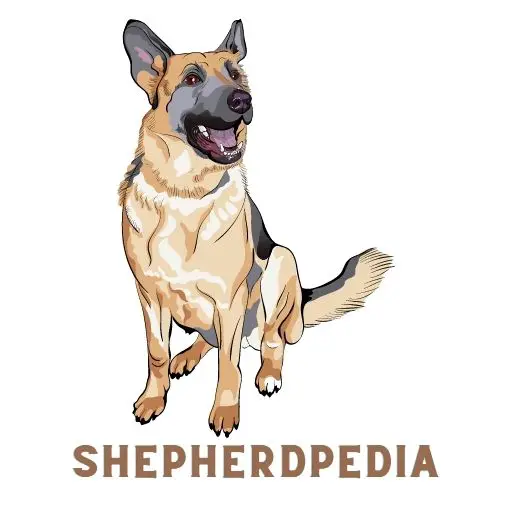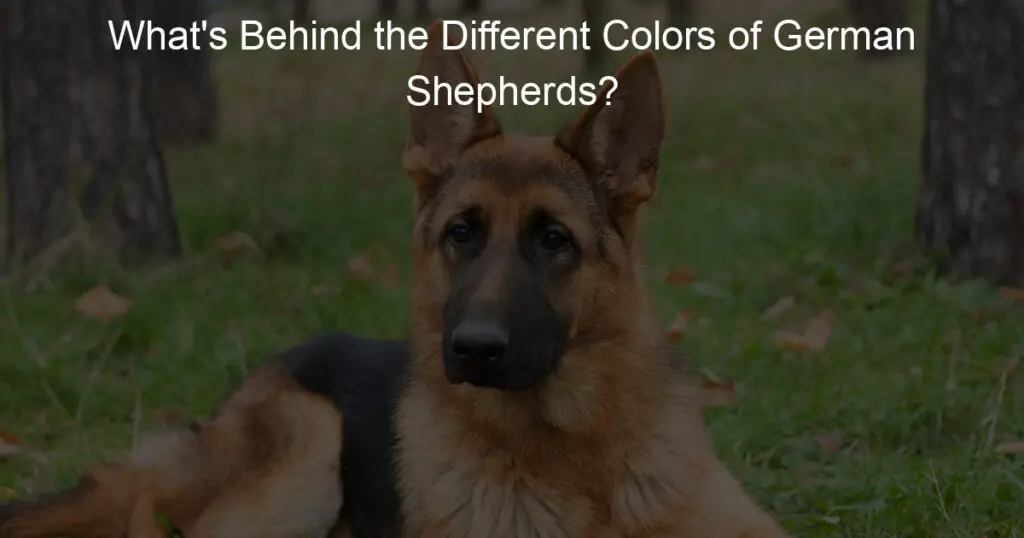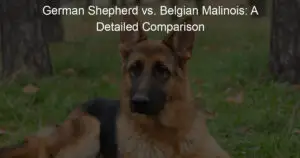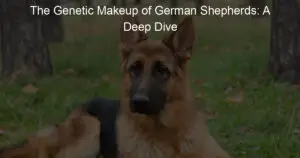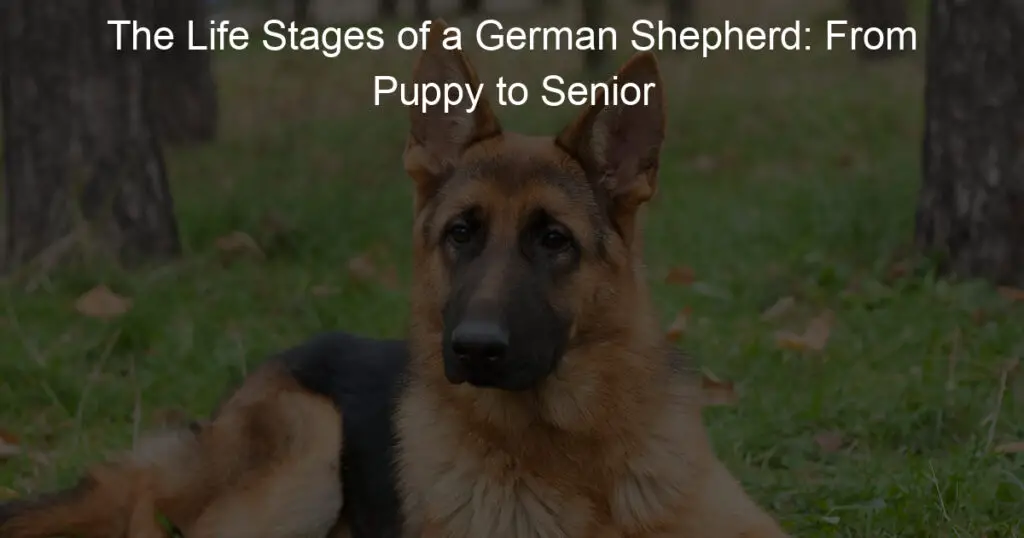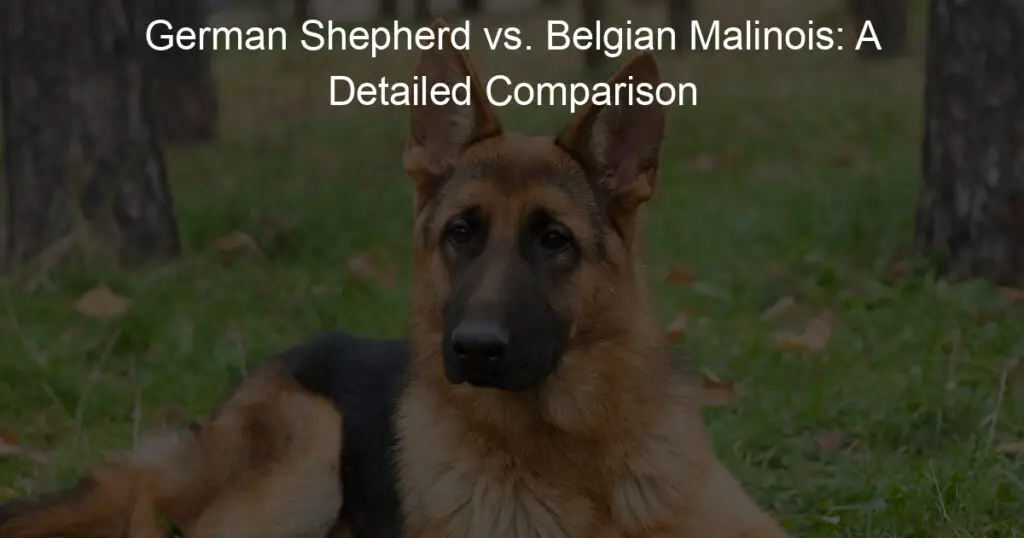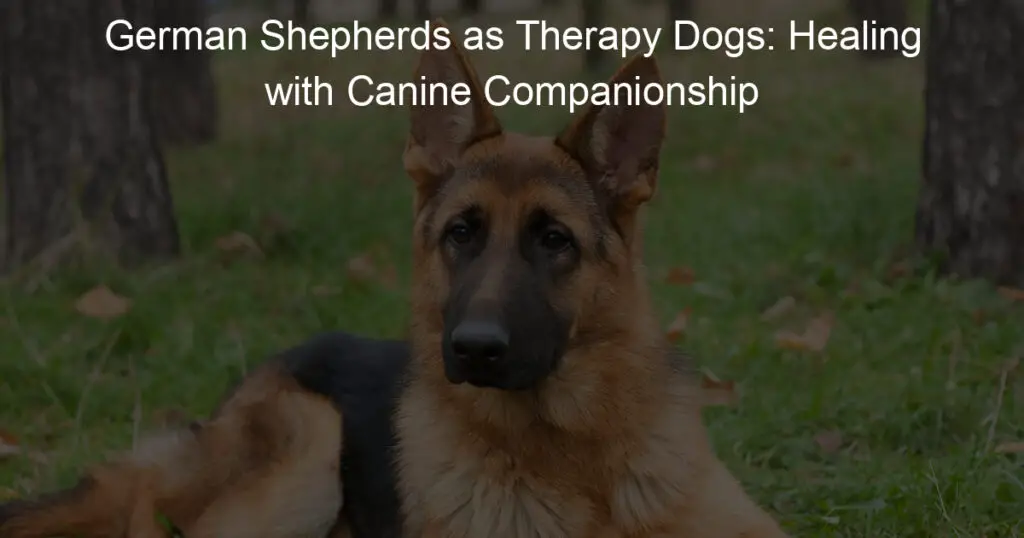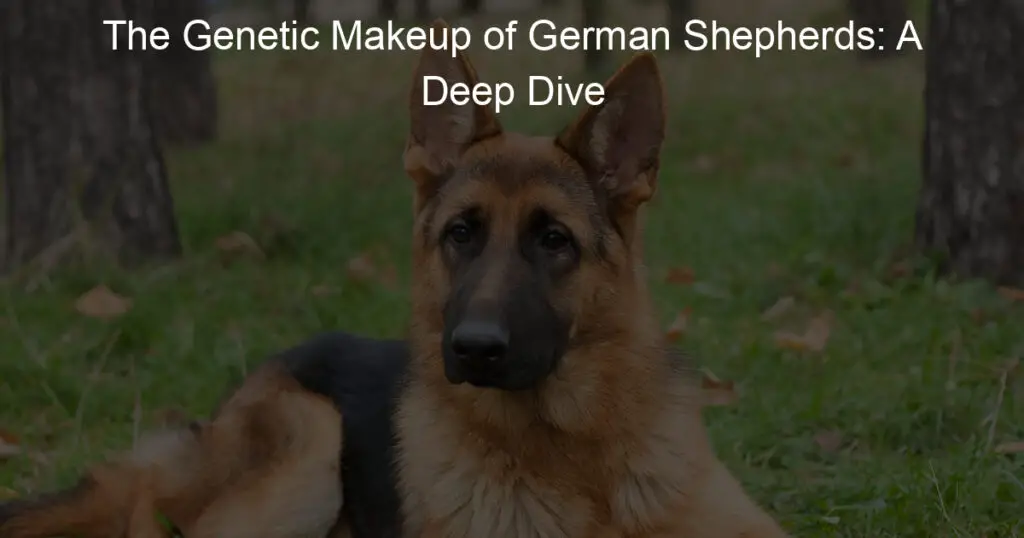This blog post delves into the fascinating world of German Shepherds, specifically exploring the reasons behind their diverse color palette. From genetics to health implications and breed standards, the article unravels the science and magic behind the variety of colors these beloved dogs come in.
Understanding the Basics of Dog Genetics
Dog genetics play a crucial role in determining the appearance and characteristics of different breeds, including German Shepherds. At its core, genetics is the study of how traits are passed down from one generation to the next through DNA. In the case of German Shepherds, coat color is one of the most noticeable traits that can vary widely among individuals.
Genes, which are segments of DNA, carry the instructions for building and maintaining an organism. Each gene has different versions called alleles, and the combination of alleles determines an individual's traits. In German Shepherds, there are specific genes responsible for controlling coat color.
The main genes involved in determining coat color in German Shepherds are the agouti gene and the melanin gene. The agouti gene controls the distribution of pigments in the individual hairs, while the melanin gene regulates the production of the pigment melanin. The interaction between these genes and their alleles leads to the wide range of colors observed in German Shepherds.
Coat color in German Shepherds can be influenced by multiple factors, including dominant and recessive alleles, as well as the presence of modifiers. Dominant alleles are those that are more likely to be expressed, while recessive alleles require both copies of the gene to be present for the trait to appear. Modifiers can enhance or suppress the expression of certain colors.
The Common Colors of German Shepherds: What Are They?
German Shepherds are known for their striking and diverse coat colors. Some of the most common colors seen in this breed include black, sable, and black and tan. Black German Shepherds have a solid black coat, which is caused by a dominant allele of the agouti gene that suppresses the production of other pigments. Sable German Shepherds have a mixture of black and tan hair, giving them a beautiful and unique appearance. The intensity of the sable color can vary, ranging from light to dark. Black and tan German Shepherds have a predominantly black coat with tan markings on their legs, chest, and face. These markings are usually present on their eyebrows, cheeks, and under the tail. Additionally, there are also bi-color German Shepherds, which have a solid black coat with lighter tan or cream markings. The common colors of German Shepherds are determined by the interaction of genes and alleles that control pigmentation. While these colors are considered standard for the breed, it's important to note that variations can occur. Coat colors can be influenced by factors such as the presence of modifiers and the expression of recessive alleles. It's this variety in coat colors that adds to the charm and individuality of each German Shepherd. Whether they are jet black, sable, or black and tan, each color variation brings its own beauty and appeal to this beloved breed.
Rare and Unique Colors: Are They Normal?
While black, sable, and black and tan are the most common colors seen in German Shepherds, there are also rare and unique coat colors that capture the attention of dog enthusiasts. These colors include blue, liver, panda, and white. Blue German Shepherds have a diluted black coat color that appears as a bluish-gray shade. This color variation is caused by a recessive gene that affects the production of pigment. Liver German Shepherds, on the other hand, have a brownish-reddish coat color that is also caused by a recessive gene. Panda German Shepherds have a predominantly white coat with black spots or patches, resembling the markings of a panda bear. White German Shepherds, while controversial in some circles, are recognized by certain kennel clubs as a distinct color variation. They have a pure white coat without any pigmentation. These rare and unique colors may not be considered "normal" in terms of breed standards, but they are still a result of natural genetic variations. It's important to note that these colors do not affect the health, temperament, or intelligence of the German Shepherd breed. However, it's essential to be cautious when purchasing a dog with these coat colors, as some breeders may exploit the rarity for profit without prioritizing the overall health and well-being of the puppies. Responsible breeders prioritize the health and temperament of the German Shepherd above the color of their coat. Ultimately, the decision to choose a rare or unique color variation should be based on personal preference, as long as it is done ethically and with the welfare of the dog in mind.
"A Closer Look at the Black German Shepherd: Is it a Separate Breed?"
The black German Shepherd is a striking and popular color variation that often captures attention. However, it is important to understand that black German Shepherds are not a separate breed. They are simply German Shepherds with a solid black coat color. This color variation is a result of a specific gene that affects the production of pigment in the fur.
Black German Shepherds have been present in the breed since its early beginnings, and they are recognized by kennel clubs worldwide. However, it is worth noting that some breeders may focus exclusively on breeding black German Shepherds, which can give the impression that they are a separate breed.
The solid black color in German Shepherds is caused by a dominant gene known as the melanistic gene. This gene inhibits the production of the usual reddish-brown pigment called eumelanin and results in a solid black coat color. Black German Shepherds can have varying degrees of blackness, ranging from a rich jet-black to a charcoal color.
Despite the misconception of them being a separate breed, black German Shepherds possess the same characteristics, temperament, and intelligence as their more commonly seen colored counterparts. They are known for their loyalty, intelligence, and versatility in various roles, including as working dogs, family pets, and search and rescue dogs.
It is important to note that while black German Shepherds are visually striking, their coat color does not determine their working ability or overall quality as a German Shepherd. Responsible breeders prioritize the health, temperament, and working capabilities of their dogs rather than solely focusing on coat color.
Does Coat Color Influence Health and Lifespan?
The color of a German Shepherd's coat does not directly influence its health or lifespan. The health and longevity of a dog are determined by a combination of genetic factors, lifestyle, diet, and overall care provided by the owner. While certain coat colors may be associated with specific health conditions in some dog breeds, there is no scientific evidence to suggest that coat color affects the health or lifespan of German Shepherds.
German Shepherds, regardless of their coat color, can be prone to certain health issues such as hip dysplasia, elbow dysplasia, and degenerative myelopathy. These conditions are more influenced by genetics and breeding practices rather than coat color. Responsible breeders conduct health screenings and genetic testing to minimize the risk of passing on these conditions to their puppies, regardless of their coat color.
It is important to note that some coat colors, such as white German Shepherds, have been associated with a higher risk of certain genetic disorders, including deafness and skin problems. However, this is not universally true for all individuals of that coat color. By choosing a reputable breeder who follows proper breeding practices and conducts health tests, potential health risks can be minimized.
Lifespan is influenced by various factors, including genetics, environment, diet, exercise, and overall veterinary care. German Shepherds generally have a lifespan of around 10 to 14 years, regardless of their coat color. Providing a balanced diet, regular exercise, routine veterinary check-ups, and a loving environment can help promote a longer and healthier life for these remarkable dogs.
The Impact of Coat Color on German Shepherd's Temperament
Coat color does not have a direct impact on a German Shepherd's temperament. The temperament of a dog is primarily determined by genetics, early socialization, training, and individual personality traits. However, there are some misconceptions and stereotypes surrounding certain coat colors and their perceived influence on temperament. Let's explore this topic further.
- 1. Misconceptions and Stereotypes:
Certain coat colors, such as black and sable, have been associated with being more protective or dominant. On the other hand, lighter colors like white or cream are sometimes thought to be more gentle or less aggressive. However, it's important to remember that these stereotypes are not based on scientific evidence and can vary from dog to dog. - 2. Genetic Factors:
Coat color is determined by genetics, and genes that control coat color do not directly influence temperament. Traits like confidence, sociability, and drive are influenced by a combination of genes that control behavior and personality. Temperament is a complex trait that is influenced by multiple factors, including genetics, socialization, training, and environment. - 3. Individual Variations:
Just like humans, each German Shepherd has its own unique personality and temperament, regardless of coat color. Some German Shepherds may be more outgoing and friendly, while others may be more reserved or protective. These individual variations are not determined by coat color but rather by a combination of genetic factors and life experiences.
How Breed Standards Affect Color
Breed standards play a significant role in determining the acceptable colors for German Shepherds. These standards are established by kennel clubs and breed organizations to maintain the integrity and uniformity of the breed. They outline the ideal characteristics that a German Shepherd should possess, including coat color.
The breed standard specifies the preferred and accepted colors for German Shepherds, which typically include black, tan, and sable. These colors are considered traditional and are most commonly seen in German Shepherds. Deviations from these preferred colors may be considered non-standard or undesirable in the show ring.
Breeders often strive to produce German Shepherds that adhere to the breed standard, including coat color. They carefully select parent dogs with desired colors to promote consistency in their breeding programs. This focus on adhering to the breed standard helps to maintain the recognizable look and characteristics of German Shepherds.
However, it's important to note that breed standards can vary slightly between different kennel clubs or organizations. Some may allow additional colors, such as solid black or solid white, while others may consider them as faults. It's crucial for breeders and enthusiasts to understand and follow the specific breed standards set by their respective organizations.
While breed standards influence the preferred colors for German Shepherds, it is essential to remember that coat color should not be the sole determining factor when selecting a dog. Temperament, health, and other characteristics should also be taken into consideration when choosing a German Shepherd as a pet or working dog.
Why Does Color Change as German Shepherds Age?
As German Shepherds age, it is not uncommon for their coat color to undergo changes. This can be attributed to several factors, including genetics, hormonal changes, and the natural aging process.
- 1. Genetics:
The Role of Genes in Coat Color Changes
Genes play a significant role in determining a dog's coat color. Some German Shepherds may carry genes that are responsible for color changes as they mature. For example, a puppy with a dark coat may gradually lighten as they grow older due to the activation of certain genes that influence pigmentation. This genetic influence can lead to a noticeable difference in coat color as the dog ages. - 2. Hormonal Changes:
The Impact of Hormones on Coat Color
Hormonal changes, particularly during puberty and adulthood, can also contribute to coat color changes in German Shepherds. The fluctuation of hormones, such as estrogen and testosterone, can affect the production and distribution of melanin, the pigment responsible for coat color. This hormonal influence can cause variations in the intensity, shade, or pattern of a German Shepherd's coat as they mature. - 3. Aging Process:
Gray Hairs and Fading Colors
Just like humans, German Shepherds also experience the natural aging process, which can result in changes to their coat color. As dogs age, they may develop gray hairs, particularly around their face, muzzle, and body. These gray hairs can gradually spread throughout the coat, causing a noticeable change in color. In addition to gray hairs, the overall intensity and vibrancy of a German Shepherd's coat may fade with age, resulting in a lighter or duller appearance.It's important to note that coat color changes in German Shepherds are generally normal and should not be a cause for concern. However, if the color change is accompanied by other symptoms, such as hair loss, skin irritation, or behavioral changes, it is advisable to consult a veterinarian to rule out any underlying health issues.
Can You Predict a Puppy's Color?
Predicting a puppy's color can be an exciting but challenging task for both breeders and prospective owners. While it is not always possible to accurately predict the exact coat color of a German Shepherd puppy, there are certain factors that can provide some clues.
Firstly, understanding the genetics behind coat color inheritance is crucial. German Shepherds have a wide range of genes that influence coat color, including those for black, sable, and tan. By examining the lineage and studying the genetic makeup of the parents, breeders can make educated guesses about the potential color possibilities for the offspring.
Secondly, observing the coat colors of previous litters from the same parents can offer insights into what to expect. If a pair of German Shepherds consistently produces puppies with similar coat colors, there is a higher chance that future litters will follow a similar pattern. However, it's important to note that genetic variations can still occur, leading to unexpected color combinations.
It's worth mentioning that certain coat color combinations are more common than others. For example, if both parents are black German Shepherds, there is a higher likelihood of the puppies being black as well. On the other hand, if one parent is sable and the other is tan, the puppies may inherit a combination of these colors.
Despite these considerations, it is important to remember that genetics can be complex, and there are always chances for surprises. Different genes can interact in unexpected ways, resulting in unique coat color combinations that may not have been predicted.
Is there a link between color and training ability?
The color of a German Shepherd's coat does not have a direct correlation with their training ability. Training ability is primarily influenced by genetics, temperament, and the effort put into training and socialization. While certain coat colors may be associated with specific traits, such as black German Shepherds being perceived as more protective, it is important not to generalize based solely on color.
When it comes to training, the key factors to consider are the individual dog's intelligence, willingness to learn, and their natural drives. German Shepherds are known for their high intelligence and trainability, regardless of their coat color. However, it is worth noting that individual variations can exist within any color group.
Training success largely depends on the owner or trainer's skills, consistency, and ability to communicate effectively with the dog. A well-structured training program that focuses on positive reinforcement, consistency, and clear communication can bring out the best in any German Shepherd, regardless of their coat color.
It is essential to remember that each German Shepherd is a unique individual, and their potential for training is influenced by a combination of genetic factors and their environment. Factors such as early socialization, exposure to different situations, and a nurturing environment play a significant role in shaping a German Shepherd's training abilities.
"The White German Shepherd: Myth or Reality?"
The white German Shepherd is not a myth but a reality. While the traditional German Shepherd color is a combination of tan and black, there are some individuals that have a solid white coat. However, it is important to note that the white coat color is considered a fault according to breed standards set by organizations like the American Kennel Club (AKC).
White German Shepherds have the same physical characteristics and temperament as their colored counterparts. They are intelligent, loyal, and protective. However, due to their coloration, they may be more prone to certain health issues like skin allergies and sunburn. Special care must be taken to protect their skin from excessive sun exposure.
Despite being considered a fault, many people find the white German Shepherds to be visually appealing and are drawn to their striking appearance. This has led to a growing interest in breeding specifically for white-coated German Shepherds. However, responsible breeders prioritize the overall health and temperament of the dog rather than focusing solely on coat color.
It is worth mentioning that white German Shepherds can still participate in various dog sports and activities, including obedience, agility, and search and rescue. Their coat color does not affect their ability to excel in these areas. In fact, their unique appearance may even make them stand out in the crowd.
How Environment Affects the Coat Color of German Shepherds
The environment plays a significant role in determining the coat color of German Shepherds. While genetics primarily determine the base color and patterns, environmental factors can influence the intensity and shade of the coat.
Firstly, exposure to sunlight can cause the coat to fade or darken. When German Shepherds are exposed to excessive sunlight, the UV rays can bleach the coat, causing it to appear lighter. On the other hand, limited exposure to sunlight can result in a darker and richer coat color. This is why German Shepherds living in areas with intense sunlight often have lighter coats compared to those in regions with less sunlight.
Secondly, temperature can also affect the coat color. German Shepherds living in colder climates tend to develop a denser and thicker coat. This is an adaptation to protect them from the cold. The increased hair density can give the illusion of a darker coat due to the added depth and volume.
Furthermore, diet and nutrition can indirectly affect the coat color of German Shepherds. A well-balanced and nutritious diet can promote healthy hair growth, making the coat appear fuller and more vibrant. Conversely, a poor diet lacking essential nutrients can result in a dull and lackluster coat.
It is important to note that while these environmental factors can influence the coat color, they do not have the power to completely change the genetic makeup or produce entirely new colors. The impact of the environment is more subtle and can enhance or diminish the natural coat color of the German Shepherd.
The Magic of Genetics: How Do Two Black German Shepherds Produce a Sable Puppy?
When two black German Shepherds produce a sable puppy, it may seem like magic, but it is actually the result of complex genetic inheritance. Sable is a unique color pattern in German Shepherds that is characterized by a mix of black or dark-tipped hairs with lighter colors such as tan or red.
To understand how this happens, we need to delve into the world of genetics. German Shepherds carry genes for different coat colors, including black and sable. While black is a dominant color, sable is a recessive color. This means that in order for a sable puppy to be born, both parents must carry the sable gene.
When two black German Shepherds mate, each parent contributes a set of genes to the offspring. If both parents carry the recessive sable gene, there is a chance that the puppy will inherit the sable gene from both parents, resulting in a sable coat color.
It is important to note that even if both parents carry the sable gene, not all of their puppies will be sable. The inheritance of coat color is a random process, and other factors such as the presence of other coat color genes can influence the final outcome. This is why even within a litter of puppies from the same parents, you may find variations in coat color, including black, sable, or other colors.
German Shepherd Colors:
| Color | Genetics | Health Implications | Breed Standards |
|---|---|---|---|
| Black and Tan | Dominant black gene | No known health implications | Accepted by breed standards |
| Sable | Dominant Agouti gene | No known health implications | Accepted by breed standards |
| Black & Red | Dominant black gene with recessive red gene | No known health implications | Accepted by breed standards |
| Solid Black | Dominant black gene | No known health implications | Accepted by breed standards |
In conclusion, the diverse array of German Shepherd colors is a testament to the breed's rich genetic diversity. While color can sometimes hint at a dog's overall health or lineage, it's essential to remember that it does not determine a German Shepherd's temperament or ability. Regardless of their coat color, every German Shepherd has the potential to be a loyal, intelligent, and highly trainable companion.
